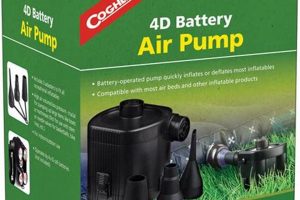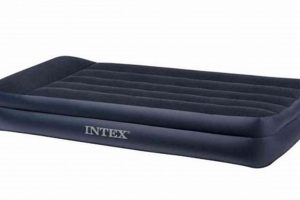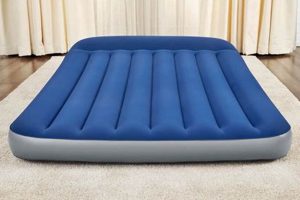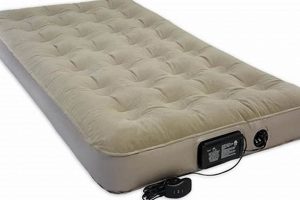A collection of materials designed to repair punctures or leaks in inflatable mattresses is commonly required for maintenance of such items. These kits typically include adhesive patches, glue, and sometimes tools for surface preparation. They enable users to address minor damage, extending the lifespan of their air mattresses and preventing complete deflation.
The utility of such a repair solution lies in its cost-effectiveness and convenience. Purchasing a new inflatable bed due to a small hole can be avoided, saving money and reducing waste. Historically, similar repair methods have been employed for various inflatable items, evolving from simple patches to specialized adhesives designed for specific materials.
The subsequent sections will delve into the specific components found in these repair solutions, the techniques for effective application, and considerations for selecting the appropriate option based on the material and severity of the damage.
Essential Repair Guidance
The following guidance aims to optimize the usage and effectiveness of an air mattress repair solution, ensuring a durable and reliable fix.
Tip 1: Thoroughly Clean the Area: Prior to application, the surface surrounding the puncture must be cleaned with isopropyl alcohol. This removes dirt and oils, promoting optimal adhesion of the patch.
Tip 2: Identify All Leaks: Submerge the inflated mattress in water to locate all punctures. Mark each location clearly with a pen or marker. Addressing all leaks in one repair session prevents repeated deflation.
Tip 3: Cut Patch to Size: Trim the patch slightly larger than the puncture. Rounded edges minimize the risk of peeling and ensure a secure seal.
Tip 4: Apply Adhesive Sparingly: Use the adhesive included in the repair solution sparingly, following the manufacturers instructions. Over-application can weaken the bond and create a messy, ineffective repair.
Tip 5: Apply Pressure Evenly: Once the patch is in place, apply firm and even pressure for the recommended duration. This ensures the adhesive bonds properly with the air mattress material.
Tip 6: Allow Sufficient Curing Time: Adhere to the recommended curing time before reinflating the mattress. Premature inflation can compromise the bond and lead to repair failure.
Tip 7: Reinforce Larger Tears: For tears exceeding a centimeter, consider using multiple overlapping patches or a fabric reinforcement beneath the patch for added durability.
Proper adherence to these guidelines ensures the effective and long-lasting repair of inflatable mattresses, preventing further air loss and extending the product’s usable life.
The subsequent section will explore different types of inflatable mattress materials and the suitability of various patching compounds for each.
1. Adhesive Strength
Adhesive strength is a foundational element in the efficacy of any inflatable mattress repair solution. It dictates the durability and reliability of the bond between the patch and the mattress material, influencing the repair’s ability to withstand pressure and stress.
- Chemical Composition
The specific chemical formulation of the adhesive directly impacts its ability to create a strong bond with the mattress material. Adhesives formulated for specific materials, such as PVC or flocked surfaces, exhibit superior adhesion compared to general-purpose adhesives. Using an incompatible adhesive may result in a weak bond that fails under pressure.
- Surface Preparation Influence
The preparation of the mattress surface prior to adhesive application significantly affects bond strength. Contaminants such as dirt, oils, or moisture impede proper adhesion. Thorough cleaning with an appropriate solvent and light abrasion to create a textured surface enhance the adhesive’s ability to grip the material.
- Curing Process and Time
The curing process, which involves the adhesive undergoing chemical changes to solidify and achieve its maximum bond strength, is critical. Factors such as temperature and humidity influence the curing time. Adhering to the manufacturer’s recommended curing time ensures the adhesive reaches its full potential and forms a robust bond. Premature use can compromise the repair.
- Long-Term Durability and Environmental Factors
The adhesive’s ability to maintain its bond strength over time is essential for a lasting repair. Environmental factors such as temperature fluctuations, humidity, and exposure to ultraviolet light can degrade the adhesive, leading to bond failure. Adhesives formulated with UV inhibitors and resistance to temperature extremes provide greater long-term durability.
In summary, the adhesive’s chemical makeup, surface preparation, curing process, and long-term durability are all critical facets of its strength and directly impact the overall effectiveness of a repair using a fix kit. Selecting a solution with a high-quality adhesive, coupled with proper application techniques, is essential for achieving a reliable and lasting repair.
2. Patch Material
The efficacy of an air mattress repair solution is significantly influenced by the composition of the patching material itself. The patch must form a durable, airtight seal when applied to the mattress surface, maintaining its integrity under pressure and stress.
- Material Compatibility
Patch composition must match the air mattress material. Most inflatable mattresses are constructed from PVC (polyvinyl chloride), flocked PVC, or TPU (thermoplastic polyurethane). A PVC patch bonds optimally with a PVC mattress, while TPU patches work best on TPU surfaces. Incompatible materials may result in poor adhesion and premature failure. Some kits include a universal patch material designed to adhere to multiple surfaces, but their effectiveness may vary.
- Thickness and Flexibility
Patch thickness influences durability, while flexibility is crucial for withstanding the constant flexing during inflation and deflation. Thicker patches resist punctures and abrasion, but excessive thickness can reduce flexibility and cause edge lifting. Thin, flexible patches conform better to the mattress surface but may be less resistant to damage. An ideal patch strikes a balance between these properties, providing both durability and flexibility.
- Surface Texture and Treatment
The surface texture of the patch can affect adhesion. Smooth patches require thorough surface preparation of the mattress and patch to ensure a strong bond. Some patches feature a textured or pre-treated surface that enhances adhesion and simplifies the repair process. For flocked mattresses, the patch may include a flocked surface to maintain the original textu
re and aesthetics of the repaired area. - Adhesive Integration
The patch material must be designed to work effectively with the adhesive included in the solution. Certain materials may require specific adhesives for optimal bonding. A repair solution that provides both a compatible patch and adhesive ensures a cohesive system that maximizes repair durability. The absence of a matching adhesive negates the benefit of having a compatible patch.
The selection of appropriate patching material within an air mattress fix kit is, therefore, central to ensuring a lasting and effective repair. Careful consideration of material compatibility, thickness, flexibility, surface texture, and adhesive integration will enhance the probability of a successful repair, extending the life of the inflatable mattress.
3. Flexibility
The role of flexibility in the context of inflatable mattress repair solutions is paramount due to the inherent dynamic nature of air mattresses. Air mattresses undergo repeated cycles of inflation and deflation, subjecting repaired areas to significant stress. A patch lacking sufficient flexibility is prone to cracking or peeling, leading to a compromised seal and eventual air leakage. Therefore, the flexibility of both the patch and the adhesive within a repair solution directly determines the longevity and effectiveness of the repair. For instance, a rigid patch applied to a heavily used area of an air mattress, such as the edge or a section frequently bearing weight, will likely fail prematurely compared to a flexible patch.
Patch flexibility must also accommodate the material properties of the air mattress itself. Different inflatable mattresses may utilize various materials, each with its own degree of inherent flexibility. A patch material that is excessively rigid relative to the mattress material will create a point of stress concentration, potentially leading to failure of the patch itself or damage to the surrounding mattress material. The adhesive, similarly, must maintain its flexibility after curing to prevent cracking or separation under stress. Silicon-based adhesives often exhibit superior flexibility compared to cyanoacrylate-based adhesives, making them a more suitable choice for air mattress repair. The impact of flexibility is further amplified by temperature changes which may cause the materials to either expand or contract.
In summary, flexibility is a crucial attribute of an air mattress repair solution, influencing its ability to withstand the repeated stress of inflation, deflation, and use. Selecting a repair solution with a flexible patch and adhesive, appropriately matched to the air mattress material, is essential for achieving a durable and lasting repair. Without adequate flexibility, the repair is likely to fail, negating the benefits of the repair solution and potentially requiring replacement of the entire mattress.
4. Water Resistance
Water resistance represents a crucial factor in the effectiveness and longevity of any air mattress repair, particularly when considering the intended use environments. The integrity of the repaired area must withstand potential exposure to moisture, whether from accidental spills indoors or from outdoor use during camping or recreational activities. A repair lacking adequate water resistance will degrade over time, leading to re-entry of air through the compromised seal. For instance, an adhesive that dissolves or weakens upon contact with water will fail, regardless of the initial strength of the bond. This leads to deflation and necessitates repeated repairs or complete mattress replacement.
The composition of both the patch material and the adhesive within an air mattress repair solution directly dictates its water resistance. PVC patches, when paired with a waterproof adhesive specifically formulated for PVC, offer a reliable barrier against water penetration. Conversely, using a water-soluble glue on a PVC patch renders the repair ineffective in humid or wet conditions. Camping applications provide a clear example: overnight condensation can compromise a non-water-resistant repair, leading to a deflated mattress and discomfort. Similarly, an air mattress used near a pool or lake is at constant risk of water exposure. Therefore, it is highly recommended to verify water resistant feature on the package before purchasing for a long use air mattress.
In conclusion, water resistance is not merely a desirable attribute but a necessity for air mattress repair solutions intended for diverse usage scenarios. The selection of a solution that explicitly guarantees water resistance, encompassing both patch and adhesive, ensures durability and reliability in the face of moisture exposure. Prioritizing this characteristic translates to extended mattress lifespan and sustained performance, eliminating the frustration associated with premature repair failure. The practical implications of overlooking water resistance can range from minor inconvenience to significant discomfort, depending on the usage context.
5. Curing Time
Curing time is a critical, often overlooked, parameter directly influencing the success of any repair executed with an air mattress fix kit. It represents the period required for the adhesive to achieve its optimal bonding strength and is dictated by the adhesive’s chemical composition and environmental conditions.
- Adhesive Formulation
Different adhesive formulations necessitate varying curing durations. Cyanoacrylate-based adhesives, for instance, generally exhibit rapid curing times, often measured in seconds or minutes. Conversely, PVC-specific adhesives may require several hours to achieve full bond strength. Using the air mattress prematurely, before the recommended curing time has elapsed, invariably compromises the repair.
- Environmental Factors
Ambient temperature and humidity exert a significant influence on curing time. Lower temperatures typically prolong curing, while higher humidity levels can either accelerate or impede the process, depending on the adhesive type. Direct sunlight exposure during curing may also degrade the adhesive. Optimal curing occurs within the temperature and humidity ranges specified by the adhesive manufacturer, if available.
- Pressure Application
Consistent pressure applied to the patched area during the curing period facilitates optimal bonding. Pressure ensures uniform contact between the patch and the mattress surface, promoting maximum adhesive transfer and minimizing air gaps. Clamps or weights may be employed to maintain consistent pressure during curing. Lack of applied pressure directly results in reduced adhesion and a weakened repair.
- Premature Inflation Risks
Premature inflation of the air mattress before the adhesive has fully cured subjects the repair to stress exceeding its current bonding capacity. This can lead to patch displacement, incomplete sealing, and subsequent air leakage. Allowing adequate curing time mitigates this risk, ensuring a durable and reliable repair that withstands the pressures of inflation and use. The risk is especially pronounced for repairs located in high-stress areas of the mattress, suc
h as seams or corners.
In summary, proper adherence to the recommended curing time for the adhesive within an air mattress fix kit is essential for maximizing repair effectiveness. Understanding the influence of adhesive formulation, environmental factors, and pressure application, along with the risks of premature inflation, allows for a more informed and successful repair, ultimately extending the lifespan of the air mattress.
6. Applicator Type
Applicator type, in the context of an air mattress fix kit, directly influences the precision and efficiency of adhesive application. The design and functionality of the applicator determine the user’s ability to apply the adhesive evenly and accurately, minimizing waste and maximizing the bond strength between the patch and the mattress. For instance, a kit employing a brush applicator allows for controlled spreading of the adhesive, ensuring complete coverage of the patch area. Conversely, a kit with a simple squeeze tube applicator may result in uneven application, leading to weak spots and a compromised seal. The applicator, therefore, constitutes an essential component of the overall repair solution, affecting both the ease of use and the ultimate success of the repair. Consider a scenario where a precise application is needed on a flocked surface, the applicator type must have an extension to get to the leak area effectively.
Various applicator designs cater to different repair scenarios and adhesive types. Fine-tipped applicators are suitable for precise applications in small areas or along edges, while broader applicators are more efficient for covering larger surfaces. Some applicators incorporate features such as flow control mechanisms to prevent excessive adhesive dispensing, reducing mess and ensuring optimal adhesive usage. The material of the applicator also affects its performance; applicators made from non-reactive materials prevent contamination of the adhesive and ensure consistent flow. The applicator’s design can also address the challenge of applying adhesive in hard-to-reach areas, such as corners or seams, through specialized nozzles or extension tubes.
In conclusion, the applicator type within an air mattress fix kit is intrinsically linked to the quality and durability of the repair. An appropriately designed applicator, matched to the adhesive properties and repair requirements, enables precise and efficient application, resulting in a stronger, more reliable seal. The choice of applicator, therefore, represents a critical consideration in the selection of an air mattress fix kit, directly impacting the user’s ability to achieve a successful and lasting repair. The cost difference between a solution with a well-designed applicator and a subpar one is generally insignificant compared to the cost of replacing the air mattress due to a failed repair.
7. Surface Preparation
Surface preparation is a critical prerequisite for achieving a successful and durable repair using an air mattress fix kit. The integrity of the bond between the patch and the mattress material hinges on the cleanliness and condition of the surfaces being joined. Inadequate surface preparation compromises adhesion, leading to premature repair failure and air leakage.
- Cleaning and Degreasing
The removal of dirt, oils, and contaminants from the mattress surface is essential for optimal adhesion. Isopropyl alcohol or a similar solvent is typically employed to degrease the area surrounding the puncture. Residual contaminants impede the adhesive’s ability to bond directly with the mattress material, resulting in a weak and unreliable seal. Failure to properly clean the surface represents a common cause of repair failure.
- Abrasion and Texturing
Light abrasion of the mattress surface with fine-grit sandpaper or an abrasive pad creates a textured surface that enhances mechanical adhesion. The textured surface provides microscopic ridges and valleys for the adhesive to grip, increasing the contact area and improving bond strength. Excessive abrasion, however, can damage the mattress material. The objective is to create a slightly roughened surface without compromising the structural integrity of the mattress.
- Drying and Moisture Removal
The presence of moisture on the mattress surface inhibits adhesive bonding. After cleaning, the area must be thoroughly dried before applying the patch. Air drying or the use of a clean, lint-free cloth effectively removes residual moisture. The use of heat, such as a hairdryer, can accelerate the drying process, but care must be taken to avoid overheating the mattress material.
- Patch Preparation
Similar to the mattress surface, the patch itself may require preparation prior to application. Some patches have a protective film that must be removed, while others may benefit from light cleaning or abrasion. Following the manufacturer’s instructions regarding patch preparation ensures optimal adhesion and compatibility with the adhesive.
In conclusion, meticulous surface preparation is an indispensable step in the air mattress repair process. Neglecting this crucial stage significantly reduces the likelihood of a successful and long-lasting repair. Proper cleaning, abrasion, drying, and patch preparation, when performed diligently, maximize the effectiveness of the adhesive and ensure a robust and airtight seal, extending the lifespan of the air mattress.
Frequently Asked Questions
The following addresses common queries and misconceptions concerning air mattress repair and the application of appropriate repair solutions. Precise understanding of the topic ensures the efficacy and longevity of any executed repair.
Question 1: Is universal patch material as effective as material-specific patches?
Universal patch material offers convenience, but its adhesion may not equal that of patches specifically designed for the air mattress material (e.g., PVC). Material-specific patches generally establish a stronger and more durable bond.
Question 2: Can a fix kit be used on flocked air mattresses?
Yes, air mattress fix kits are applicable to flocked surfaces. However, thorough cleaning of the flocked area surrounding the puncture is imperative to ensure proper adhesive contact. Removal of flocking fibers may be necessary in extreme cases.
Question 3: How long should the repair cure before the mattress is used?
Curing time varies based on adhesive composition and environmental conditions. Adherence to the manufacturer’s recommended curing duration, typically found on the adhesive packaging, is crucial for optimal bond strength.
Question 4: Is it possible to repair large tears in an air mattress?
While small punctures are readily addressed with a fix kit, large tears may necessitate more extensive repair techniques, potentially including fabric reinforcement or professional repair services. The severity of the damage dictates the feasibility of repair.
Question 5: Does temperature affect the adhesive’s performance?
Temperature significantly influences adhesive performance. Extreme temperatures can compromise bond strength. Repairs should be performed within the temperature range specified by the adhesive manufac
turer for optimal results.
Question 6: How to properly store unused repair solution?
Adhesives and patch materials must be stored in a cool, dry environment, away from direct sunlight and extreme temperatures. Proper storage extends the shelf life of the solution, ensuring its effectiveness when needed.
In summary, the successful application of a repair solution hinges on material compatibility, proper surface preparation, adherence to curing times, and consideration of environmental factors. Addressing these key aspects optimizes the durability and reliability of the repair.
Concluding Remarks
This exploration has elucidated the essential aspects of the air mattress fix kit, emphasizing the critical roles of adhesive strength, patch material compatibility, flexibility, water resistance, curing time, applicator type, and surface preparation. Each element contributes significantly to the ultimate effectiveness and longevity of any repair performed. A comprehensive understanding of these factors is paramount for consumers seeking to maintain and extend the lifespan of their inflatable mattresses.
The selection and judicious application of an air mattress fix kit represents a responsible approach to product maintenance, reducing waste and minimizing the need for premature replacements. Adherence to best practices, coupled with informed product selection, will ensure reliable performance and prolonged usability, thereby maximizing value and minimizing environmental impact.







